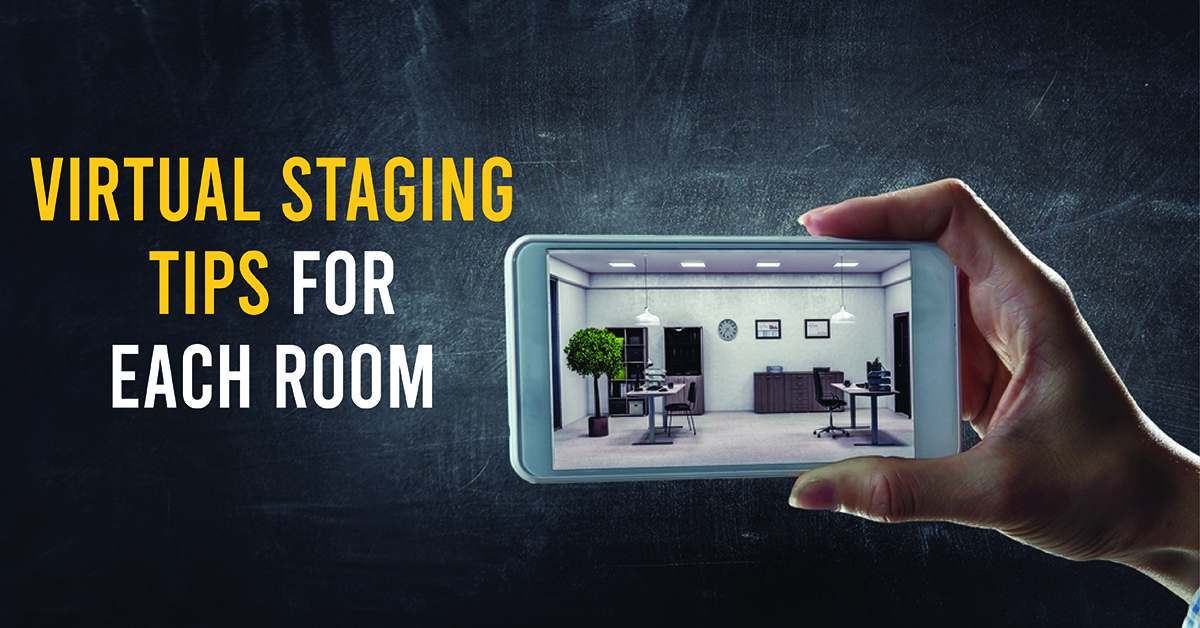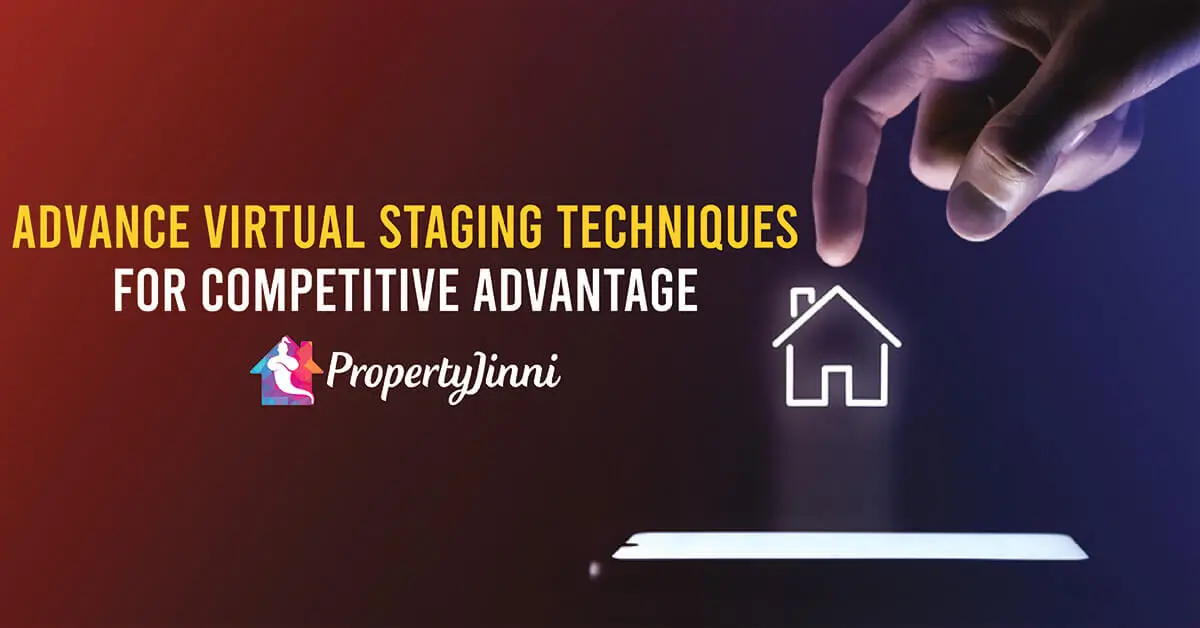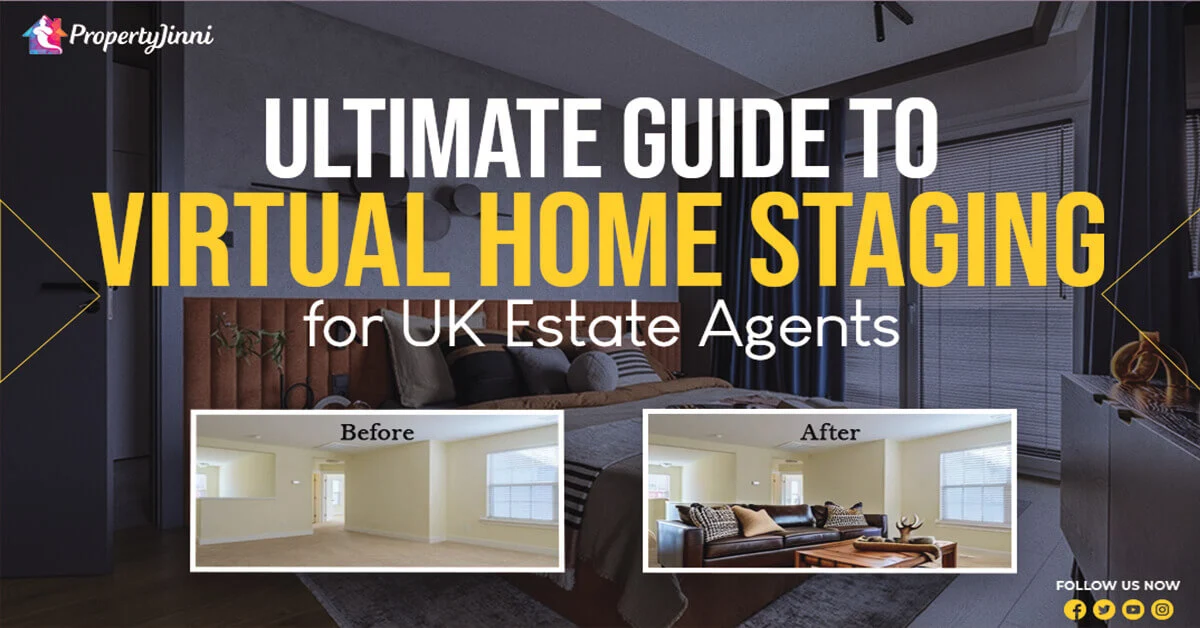The Importance of Virtual Home Staging
The adoption of AI has made home staging crucial for selling a property in 2024, and soon it would be essential part of marketing your property. By strategically arranging and decorating a home digitally, estate agents can help potential buyers envision themselves living there, ultimately increasing the chance of a sale. You can use various tools like propertyjinni.co.uk to virtual stage your property with a single press of a button. Let’s explore some key strategies for successful home staging.
Enhancing Visual Appeal
1. Maximizing Curb Appeal
The first impression matters, and that starts with curb appeal. Enhance the exterior by ensuring the lawn is well-maintained, the garden is tidy, and the front door is inviting. Consider editing the property pictures to show that the front door is well painted and adding potted plants or flowers to create an attractive entrance.
2. Creating a Welcoming Entrance
The entrance sets the tone for the rest of the property. Edit the pictures to make the property clutter-free, and consider adding a statement mirror or artwork to make the space more extensive and welcoming. Place a shoe rack or coat hooks to keep the area organised.
3. Showcasing Key Features
Highlight the property’s best features by arranging furniture and decor to attract attention. If possible give the potential buyers few design exampled. If there’s a beautiful fireplace, centre the seating area around it to make it a focal point. Use lighting to accentuate architectural details or artwork.
Highlighting Space and Functionality
1. Decluttering and Depersonalizing
Clutter can make a space appear smaller and distract potential buyers. Digitally remove countertops, pack away personal items, and organize storage spaces. This ensures buyers can envision themselves living in the space without any distractions.
2. Optimising Furniture Placement
Arrange furniture in a way that maximises space and flow. Remove any unnecessary or oversised pieces to make rooms appear more spacious. If the existing furniture is not a standard UK design and consider changing the furniture. Use furniture placement to create natural pathways and highlight functionality.
3. Accentuating Room Purpose
Define each room’s purpose to help buyers understand the potential of the space. Stage rooms to reflect their intended function. For example, style a spare room as a home office or a guest bedroom to help buyers visualize its potential uses. If you have to remove/move few walls to create extra space or modernise the property then do that to show that option to potential buyer.
Related Search: Strategies for Boosting Earnings: A Guide for UK Estate Agents in 2024
Making a Lasting Impression
1. Creating an Emotional Connection
Create an emotional connection between the buyers and the property to leave a lasting impression. Use appealing color schemes and decor that evoke positive emotions. Add personal touches such as fresh flowers to create a feeling of warm and inviting atmosphere digitally.
2. Sparking Buyer’s Imagination
Staging should go beyond just showcasing what’s there; it should help buyers imagine their lives in the space. Use staging techniques such as setting the dining table or creating a cozy reading nook to help buyers visualize how they would use the space. You can digitally add a happy family in the living room as well to show that.
3. Differentiating from Competitors
Highlight what sets the property apart from others on the market. If your competitors are still not using a virtual staging tool like propertyjinni.co.uk then take a lead and start using it. Using PropertyJinni showcase unique features, upgrades, or architectural details that differentiate it from similar properties. This will help create a sense of value and competition among potential buyers.
Essential Steps for Virtual Staging The Property
Before beginning the internal digital staging process, preparing the property to ensure it looks its best is essential. These steps will help create a solid foundation for successful staging.
A. Deep Cleaning and Repairs
1. Digitally Tackling Maintenance Issues
Digitally fixing any visible maintenance issues such as leaky faucets or cracked tiles. These minor edits can make a big difference in the overall impression of the property.
2. Freshening Up with Paint
A fresh digital coat of paint can transform a space and make it feel newer and well-maintained. Stick to neutral colors to appeal to a wide range of buyers. Consider repainting areas that show signs of wear and tear.
3. Adding Polishing Effects to Floors and Surfaces
Digitally clean and polish all flooring surfaces, including carpets, hardwood, and tile. Ensure all surfaces, such as countertops and fixtures, are spotless and stains-free.
B. Lighting and Ambiance
1. Maximising Natural Light
Open curtains or blinds and add brightness and contrast to the picture to maximise the natural light coming into the property. Natural light colour creates a sense of warmth and enhances the visual appeal of the space.
2. Choosing Appropriate Lighting Fixtures
Ensure that each room is properly design when it comes to lighting pictures and well-lit. Use a combination of overhead, task, and ambient lighting to create a balanced and welcoming atmosphere.
3. Setting Optimal Mood and Atmosphere
The right ambiance can greatly influence buyers’ perceptions of a property. Consider using soft, warm evening lighting or adding candles to create a cozy atmosphere. Add light background music to your pictures to enhance the mood further.
C. Considering Target Market
Understanding the buyer demographics and current market trends is essential for effective virtual home staging. Tailor the staging to appeal to the ideal buyers and stand out in the market.
1. Understanding Buyer Demographics
Research and understand who the target buyers are for the property. Consider their preferences, lifestyle, and potential uses for the space. This knowledge will help guide the virtual staging process.
2. Tailoring Staging to Ideal Buyers
Once you have identified the target buyers, stage the property to align with their preferences. For example, if the property appeals to young families, digitally add a kid-friendly space with play areas and functional storage solutions.
3. Researching Current Market Trends
Stay up to date with current market trends and popular home design styles. Incorporate elements of these trends into the staging to ensure the property feels modern and appealing to potential buyers.
Virtual Staging Tips for Each Room

Every room in a property requires attention to detail and thoughtful virtual staging. Consider these tips for each room to create a cohesive and irresistible space digitally.
A. Living Room and Common Areas
1. Arranging Cozy Seating Areas
Create inviting seating arrangements that encourage conversation and relaxation. Use comfortable looking furniture and arrange it to promote easy flow and interaction.
2. Accessorizing with Neutral Décor
Choose neutral decor items that complement the overall color scheme of the room. Add throw pillows, blankets, and artwork to create visual interest without overwhelming the space.
3. Adding Warmth with Textiles
Incorporate textiles such as rugs, curtains, and throws to add warmth and texture to the living room. These elements create a cozy and inviting atmosphere.
B. Kitchen and Dining Area
1. Decluttering and Organizing Countertops
Digitally remove the countertops of unnecessary items to create a sense of space and cleanliness. Add a few tasteful accessories like a stylish coffee maker or a bowl of fresh fruit.
2. Showcasing Modern Appliances
Highlight modern and updated appliances to attract buyers who prioritise a functional and stylish kitchen. Ensure that all appliances are clean and in good working condition.
3. Adding a Touch of Greenery
Digitally add potted plants or fresh herbs on the windowsill or centre island to bring life to the kitchen. Greenery adds a natural and vibrant touch to the space.
C. Bedrooms and Home Offices
1. Creating a Tranquil Retreat
Virtually stage bedrooms are tranquil and relaxing spaces. Use soft bedding, muted colours, and simple decor to create a calming atmosphere. Remove personal items and clutter to make the room feel more spacious.
2. Utilising Space-Enhancing Furniture
Choose furniture pieces that maximize space in bedrooms and home offices. For small homes try opting for multi-functional furniture such as a desk with built-in storage or a bed with drawers underneath.
3. Emphasizing Productivity for Home Offices
Arrange the home office to reflect productivity and functionality. Add a comfortable looking desk chair, a functional desk lamp, and practical storage solutions to create an enticing workspace.
D. Bathrooms and Laundry Rooms
1. Ensuring Pristine Looking Cleanliness
Cleanliness is crucial in bathrooms and laundry rooms. Digitally scrub all fixtures, clean the grout, and edit any signs of mold or mildew. Display fresh towels and show the space spotless.
2. Updating Fixtures for a Modern Look
Replace outdated fixtures with modern alternatives to give the bathrooms and laundry rooms a fresh and updated appearance. Consider adding stylish hardware, faucets, and showerheads.
4. Including Spa-Like Elements
Create a spa-like atmosphere by incorporating luxurious elements such as scented candles, fluffy towels, and bath products. Add a small stool or bench in the shower area to evoke relaxation.
E. Outdoor Spaces
1. Enhancing Functional Outdoor Areas
Virtually stage outdoor spaces to showcase their functionality and potential for entertaining. Arrange patio furniture to create inviting seating areas and consider adding outdoor rugs or cushions.
2. Landscaping and Gardening Tips
Ensure that the lawn is looking well-maintained, and the landscaping is looking tidy. Add potted plants or flowers to enhance the overall visual appeal of outdoor spaces.
3. Creating an Inviting Entertainment Space
Virtually stage outdoor spaces for entertaining by including features like a dining table or a fire pit. Use outdoor lighting to create a cozy and inviting atmosphere for evening gatherings.
Advance Virtual Staging Techniques for Competitive Advantage

Leverage these additional staging techniques to gain a competitive advantage in the real estate market.
A. Virtual Staging and 3D Tours
1. Utilizing Technology to Attract Buyers
Virtual staging can be further extended to 3D tours to allow potential buyers to visualize the property remotely. Utilize these technologies to showcase the property’s potential and generate interest.
2. Showcasing Alternative Layouts
Use virtual staging to showcase different furniture arrangements or layout possibilities. This lets buyers see the property’s flexibility and envision how to personalize the space.
3. Highlighting Potential Renovation Options
Virtual staging can also demonstrate the potential of a property through renovations or upgrades. Showcase the possibilities of an unfinished basement or an outdated kitchen to spark the buyer’s imagination.
A. Art of Virtually Home Staging Photography
1. Capturing High-Quality Listing Photos
If you are not using automatic virtual staging tools like propertyJinni.co.uk then you would need to invest in professional photo modification software’s to add the best light to the property. Well edited photos through professional tools would be crucial for attracting buyers online and generating interest.
2. Strategic Angles and Composition
Generate photos with properly chosen angles and compositions that showcase the property’s best features. Highlight spacious layouts, architectural details, and natural light in the photos.
4. Post-Processing for Stunning Images
Post-process the photos to enhance their visual appeal. Adjust brightness, contrast, and colour saturation to ensure the photos stand out to potential buyers.
C. Utilizing Virtual Staging Professionals
1. Benefits of Hiring a Staging Expert
Consider hiring a professional web designer to ensure the property is digitally staged to its highest potential. Web designers have the knowledge and experience to create a compelling and marketable space.
2. Finding Reliable Stagers
Research and choose web designers/ Digital staging professionals with a track record of success in the local real estate market through fiver.com or upwork.com. Ask for referrals, check their portfolio, and read reviews before deciding.
3. Collaborating for Desired Results
Work closely with the web designers to communicate your vision and goals for the property. Collaborate on staging to ensure the final result aligns with your objectives.
Related Search: How can AI Chatbots Improve Customer Engagement in Real Estate?
Summary & Top FAQs
In summary, Virtual home staging is a crucial aspect of selling a property. By digitally enhancing visual appeal, highlighting space and functionality, creating a lasting impression, and utilizing various staging techniques, estate agents can make properties irresistible to potential buyers.
Q1: How much does virtual home staging cost, and is it worth the investment?
Virtual home staging costs vary depending on the property’s size and scope of work. However, studies have shown that staged homes sell faster and for higher prices, making it a worthwhile investment in the selling process. The process of virtual home staging is a lot cheaper than physically staging the home. With tools like propertyjinni.co.uk it can be done automatically but if you want to do that manually than you should be able to get well edited pictures of one property for £250-£500.
Q2: Can I virtually stage a property myself, or should I hire a professional?
If you have web designing skills then it’s possible to stage a property yourself, though hiring a professional web designer with experience in virtual staging of properties in the UK can ensure higher expertise and attention to detail. Professional web designers have experience in creating spaces that appeal to a wide range of buyers, increasing the chances of a successful sale.
Q3: How do I choose the right virtual staging furniture and accessories?
When choosing virtual staging furniture and accessories, opt for neutral, timeless pieces that appeal to many buyers. Consider the size and style of the property, as well as the target market, to select furniture and decor that complement the space.
Q4: Should I virtually stage every room in a property?
While it’s ideal to virtually stage every room in a property, focus on staging the key areas buyers prioritise, such as the living room, kitchen, and primary bedroom. Virtually staging these areas creates a solid first impression and helps buyers envision themselves living in the space.
Q5: How far in advance should I start staging a property before listing it?
Start the virtual staging process as soon as you have floor plans or initial pictures to ensure a smooth and effective selling process. Ideally, begin virtual staging preparations a few weeks before listing the property to allow ample time for web editing.
By following these home virtual staging strategies, estate agents can effectively transform properties into digitally irresistible spaces that capture the attention of potential buyers. Remember, successful virtual staging requires attention to detail, understanding the target market, and utilising techniques to give the property a competitive advantage. Good luck with your virtual home staging endeavours!
